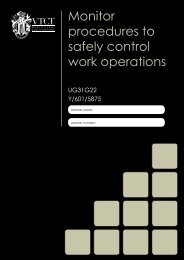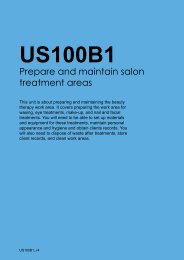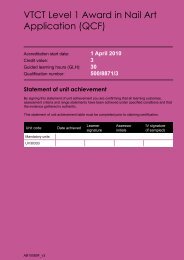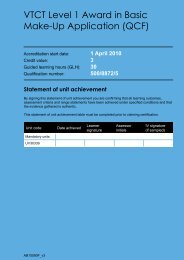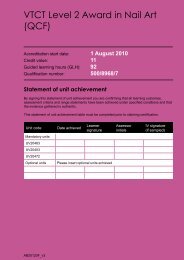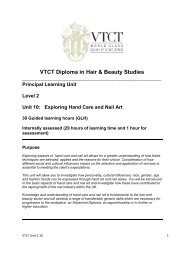Observations - VTCT
Observations - VTCT
Observations - VTCT
You also want an ePaper? Increase the reach of your titles
YUMPU automatically turns print PDFs into web optimized ePapers that Google loves.
Outcome 2: Be able to provide a body massage treatment (continued)<br />
basilica, cephalic, subclavian, saphenous<br />
(long and short), venous arch, femoral,<br />
popliteal, posterior tibial, anterior tibial.<br />
Blood – plasma, leucocytes (granulocytes<br />
and agranulocytes), erythrocytes,<br />
thrombocytes.<br />
Cardiovascular functions: Transport,<br />
defence, clotting, regulation and<br />
homeostasis.<br />
Examples of cardiovascular disorders<br />
and diseases: Anaemia, aneurysm,<br />
angina, arrhythmias, arteriosclerosis,<br />
atherosclerosis, congenital heart disease,<br />
deep vein thrombosis, gangrene,<br />
haemophilia, hematoma, HIV/AIDS,<br />
high cholesterol, hepatitis, hypertension,<br />
hypotension, leukemia, myocardial<br />
infarction, palpitations, phlebitis,<br />
pulmonary embolism, raynauds syndrome,<br />
septicaemia, sickle cell anaemia, stroke,<br />
thrombosis, varicose veins.<br />
Lymphatic system structure: Lymph,<br />
lymph capillaries, lymphatic vessels,<br />
lymph nodes, lymphatic trunks, lymphatic<br />
ducts (thoracic and right lymphatic duct),<br />
subclavian veins, nodes (axillary, cervical<br />
– superficial and deep, inguinal, intestinal,<br />
occipital, popliteal, post-auricular, parotid,<br />
supratrochlear), appendix, peyers patches,<br />
spleen, tonsils, thymus.<br />
Lymphatic functions: Subsidiary<br />
circulation (lymph formation), immunity,<br />
return of lost plasma proteins to the blood,<br />
transport dietary lipids.<br />
Examples of lymphatic disorders and<br />
diseases: Oedema, Hodgkin’s disease,<br />
non-Hodgkin’s lymphoma, lupus, cellulite,<br />
glandular fever, lymphadenitis.<br />
Nervous system structure:<br />
Central Nervous System (CNS) –<br />
brain, spinal cord, white matter, grey<br />
matter, meninges (pia mater, arachanoid<br />
mater, subarachanoid space, dura<br />
mater), cerebrospinal fluid, blood brain<br />
barrier, cerebrum, cerebellum, thalamus,<br />
hypothalamus, pituitary, pineal.<br />
Brain stem – midbrain, pons varoli,<br />
medulla oblongata.<br />
Peripheral Nervous System (PNS) –<br />
spinal nerves (31 pairs), spinal nerve<br />
plexus (cervical, brachial, lumbar, sacral,<br />
coccygeal), cranial nerves (12 pairs).<br />
Autonomic Nervous System (ANS) –<br />
sympathetic and parasympathetic divisions.<br />
Cells – neuroglia (schwann cells,<br />
oligodendrocytes, astrocytes, microglia),<br />
neurones (sensory, motor, interneuron,<br />
dendrite, cell body, axon, axon end<br />
terminals, neurotransmitters, myelin<br />
sheath, nodes of ranvier, neurolemma).<br />
Reflex arc, synapse, motor point.<br />
Nervous functions – sense internal/<br />
external stimuli, interpret and respond<br />
to stimuli, maintain homeostasis,<br />
programming, instinctual behaviour,<br />
assimilation, memory, learning, intelligence.<br />
Nervous disorders and diseases: Bells<br />
palsy, carpal tunnel syndrome, cerebral<br />
palsy, depression, epilepsy, meningitis,<br />
migraine, multiple sclerosis, neuritis,<br />
Parkinson’s disease, sciatica.<br />
Digestive system structure:<br />
Tract – alimentary canal (inner mucosa,<br />
submucosa, muscle layer, serous<br />
membrane), mouth, salivary glands,<br />
tongue, teeth, pharynx, oesophagus,<br />
stomach, small intestine (duodenum,<br />
UV30424 89





